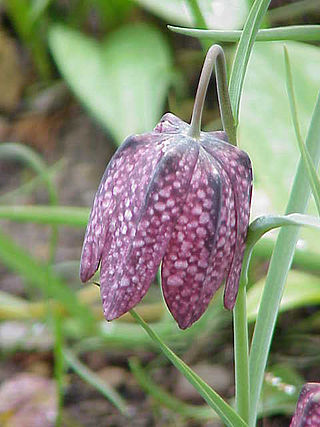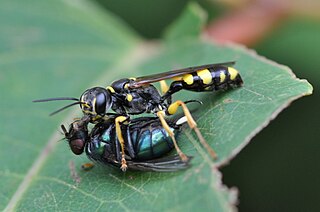
Fritillaria imperialis, the crown imperial, imperial fritillary, Kaiser's crown, or Kurdish tulip is a species of flowering plant in the lily family Liliaceae, native to a wide stretch from the Anatolian plateau of Turkey, Iraq and Iran to Afghanistan, Pakistan, Northern India and the Himalayan foothills. It is also widely cultivated as an ornamental and reportedly naturalized in Austria, Sicily, and Washington State, USA. The common names and also the epithet "imperialis", literally "of the emperor", refer to the large circle of golden flowers, reminiscent of an emperor's crown.

Fritillaria (fritillaries) is a genus of spring flowering herbaceous bulbous perennial plants in the lily family (Liliaceae). The type species, Fritillaria meleagris, was first described in Europe in 1571, while other species from the Middle East and Asia were also introduced to Europe at that time. The genus has about 130–140 species divided among eight subgenera. The flowers are usually solitary, nodding and bell-shaped with bulbs that have fleshy scales, resembling those of lilies. They are known for their large genome size and genetically are very closely related to lilies. They are native to the temperate regions of the Northern hemisphere, from the Mediterranean and North Africa through Eurasia and southwest Asia to western North America. Many are endangered due to enthusiastic picking.

The national flag of Dominica was adopted on 3 November 1978, with some small changes having been made in 1981, 1988, and 1990. The original flag was designed by playwright Alwin Bully in early 1978 as the country prepared for independence.

The Imperiali quota or pseudoquota is an unusually-low electoral quota named after Belgian senator Pierre Imperiali. Some election laws used in Single transferable voting (STV) and largest remainder systems mandate it as the portion of votes needed to guarantee a seat.

Eacles imperialis, the imperial moth, is a member of the family Saturniidae and subfamily Ceratocampinae. It is found mainly in the East of South America and North America, from the center of Argentina to south Canada. The species was first described by Dru Drury in 1773.

Trajan's Market is a large complex of ruins in the city of Rome, Italy, located on the Via dei Fori Imperiali, at the opposite end to the Colosseum. The surviving buildings and structures, built as an integral part of Trajan's Forum and nestled against the excavated flank of the Quirinal Hill, present a living model of life in the Roman capital and a glimpse at the restoration in the city, which reveals new treasures and insights about ancient Roman architecture.

Francavilla Fontana is a town and comune (municipality) in the province of Brindisi and region of Apulia, in southern Italy. It is also called the town of the "Imperiali", after the Imperiali, a family of feudal lords who ruled the town from the end of 16th century until the 18th century. With a population of 36,358, in 2017, it is the third municipality of its province after Brindisi and Fasano. Its one of the many towns in south Italy where the Greek dialect Griko is spoken.

The imperial amazon or Dominican amazon, also known as the sisserou or sisserou parrot, is a parrot found only on the Caribbean island of Dominica. It has been designated as the national bird of Dominica, and features on the national flag of Dominica. The species is critically endangered. In 2019, it was estimated there were only about 50 mature individuals left in the wild.
Aeronautica Imperialis is the name of two tabletop miniature wargames set within the Warhammer 40,000 universe. The games depict aerial warfare between different factions in the setting, either as one-off battles or as part of a larger narrative campaign. The first edition was released in January 2007 by Forge World, a division of the British gaming company Games Workshop. The second edition, a relaunch via Games Workshop, was released in August 2019 with a different ruleset and new, larger models.

The Via dei Fori Imperiali is a road in the centre of the city of Rome, Italy, that is in a straight line from the Piazza Venezia to the Colosseum. Its course takes it over parts of the Forum of Trajan, Forum of Augustus and Forum of Nerva, parts of which can be seen on both sides of the road. Since the 1990s, there has been a great deal of archaeological excavation on both sides of the road, as significant Imperial Roman relics remain to be found underneath it.

Ipomoea nil is a species of Ipomoea morning glory known by several common names, including picotee morning glory, ivy morning glory, ivy-leaf morning glory, and Japanese morning glory. It is native to the tropical Americas, and has been introduced widely across the world.

Cymbiola imperialis, the imperial volute, is a species of sea snail, a marine gastropod mollusk of the genus Cymbiola in the family Volutidae, the volutes.

Mellinus is a genus of wasps in the family Mellinidae. The species are found in the Palearctic, Nearctic, the Neotropics and the Orient. 16 species are known
Prasinalia imperialis, the algodones white wax jewel beetle, is a species of metallic wood-boring beetle in the family Buprestidae. It is endemic to the Algodones Dunes in North America.
Isthmocoris imperialis is a species of big-eyed bug in the family Geocoridae. It is found in Central America and North America.

Eupompha is a genus of blister beetles in the family Meloidae. There are about 14 described species in Eupompha.
Mellinus rufinodus is a species of wasp in the family Mellinidae. It is found in Central America and North America.
Eupompha imperialis is a species of blister beetle in the family Meloidae. It is found in North America.
Bolbocerastes imperialis is a species of earth-boring scarab beetle in the family Geotrupidae. It is found in North America.

Lycorma imperialis is a planthopper indigenous to parts of China and Indo-Malaysia. L. imperialis was originally discovered in 1846 by Adam White and has one recognized non-nominate subspecies, L. i. punicea. L. imperialis has undergone a number of reclassifications since its discovery and is one of four species in the genus Lycorma. L. imperialis follows a hemimetabolous life cycle and will undergo a series of nymphal stages (instars) before maturing to an adult.













